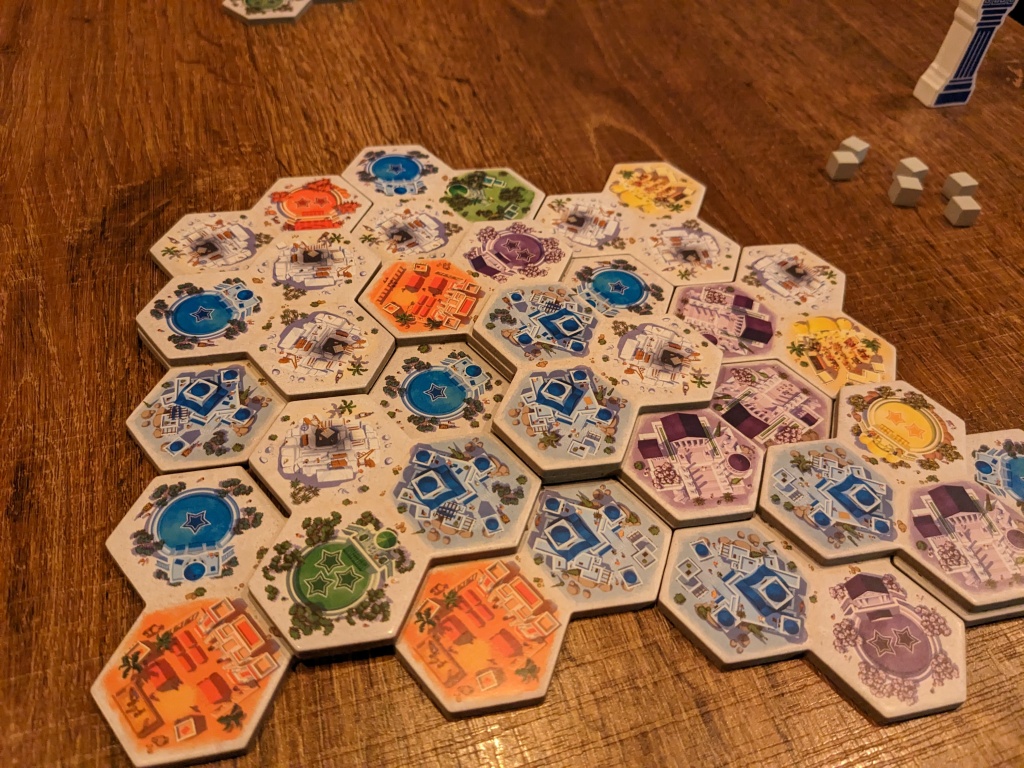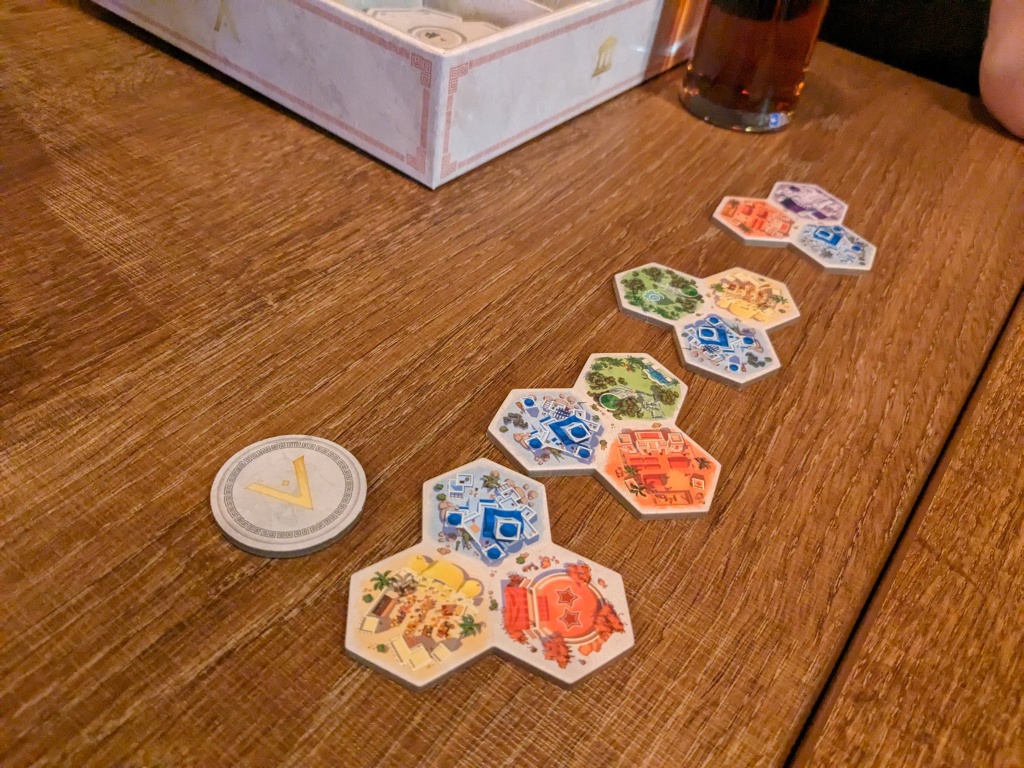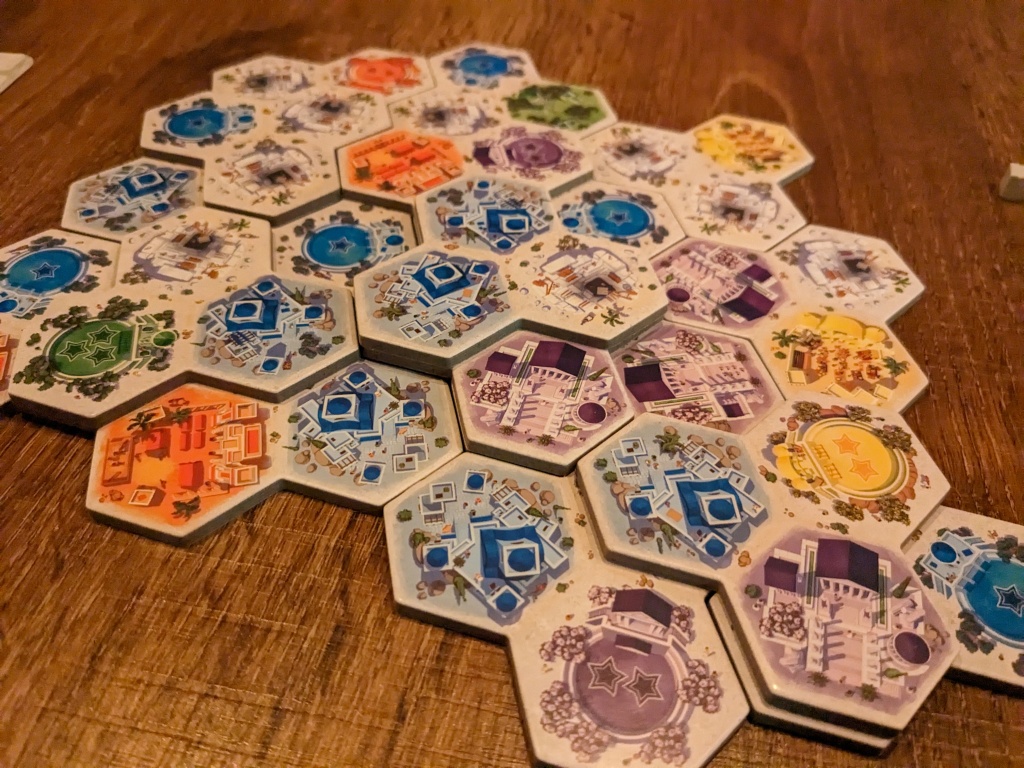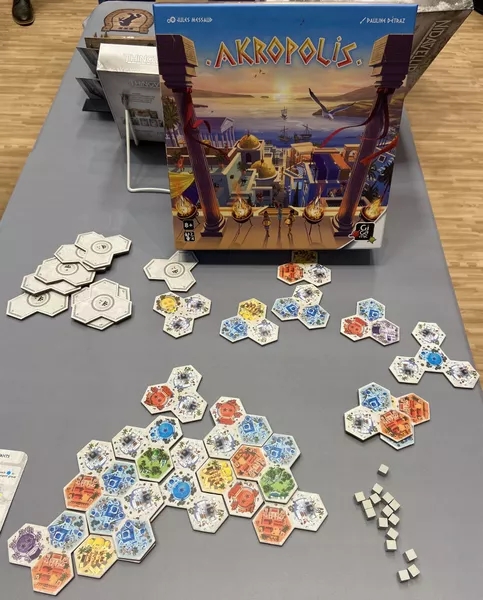Introduction
One of the things I enjoy most about board games is their tactile nature. And nothing feels more tactile than laying some thick cardboard tiles. There’s a lot I love about games, but give me some tiles and an efficiency puzzle, and I’ll be happy until the cows come home.
A lot of my favourite games feature tile laying in some respect. Isle of Skye, Castles of Burgundy, Calico, Patchwork, Barenpark, I could go on and on. I just love the progression and sense of accomplishment that you get by building something in most of these games. So how does Akropolis stack up? Read on to find out!
How to Play
Akropolis, designed by Jules Messaud and published by Gigamic, is a tile laying game where you’re trying to build up a settlement. The game starts you off with a special starter tile, which has 4 hexagons arranged in a Y shape. A blue star sits in the centre and 3 white buildings surround it.

The rest of the tiles are city tiles. These tiles consist of 3 hexagons in a triangle pattern. Each hexagon on these tiles depict one of the 6 buildings types in this game. The blue buildings are housing districts, which want to be adjacent. The yellow market buildings detest competition, and must not be adjacent to any other market. The red barracks must have along the edge of your city, while the purple towers must be completely surrounded. The green have no requirements, but there’s very few of them. Finally, the white buildings offer no value in terms of points, but if you manage to build over the white buildings, you get a piece of stone which is a valuable resource. To add some complexity, each building has an alternate scoring method that I won’t mention here.
The city tiles are stacked based on the number of players (N+1), and any remaining tiles form the market row. A turn in Arkopolis is as simple as can be. Take a tile from the market row, and place it in your city. Now, you do have to take the left most tile, but you can choose to pay one of your stone to take a tile further down the line if you so wish. Placing the tile in your city is fairly unrestricted. Either place it so at least one edge is touching another edge, or, you can build on top of existing tiles, provided the tile placed on the higher level is sitting on three hexes from at least two different tiles.
Some of these buildings depict stars, which add to your score multiplier for that colour. At the start of the game, you only have 1 blue star, meaning that every other colour starts with a times 0 multiplier! You need to acquire the right buildings to earn the right to score any points!
If the market row gets picked down, so there’s only one tile remaining, you refresh it with one of the tile stacks you set aside earlier. If there is one tile remaining and no stacks left, the game ends. Each player calculates their score, and the player with the most points is the winner.
Review
It’s not something I admit freely, but I usually don’t like learning games from other people. I like to have the rule book in my hand and be the one to teach the table how to play a new game. I get cagey that an important rule gets missed, or that some exception gets missed. So when I met up with Ryan Rau of Mista Rau’s Gaming, and he taught me how to play Akropolis without ever touching the rule book, I was a bit nervous. And when he proclaimed that there were so few restrictions on tile placement, I was dubious.

But I’m happy my fears were unfounded! Akropolis is as simple as can be. Pick a tile from the row, place it in or on your city, and score at the end of the game. Get stone when you overbuild white buildings, and use the stone as a resource to jump the building queue to get the tiles you actually want. It’s clean, easy, and quick to get started.
The production on Akropolis is no slouch. The cardboard is thick, which makes the tiles feel great to hold, and gives your city a nice elevation when you start to reach that third level. The insert is just folded cardboard, but highly functional, holding all the tiles in place. There’s not a lot of art to talk about beyond the colourful cover on the box, the tiles just depict a bird’s eye view of little clusters of buildings. With the thickness and size of the tiles, your city sprawls out and up in a very satisfying way, like a loaf of sourdough bread.
I love building my city up, turning useless tiles into multipliers of helpful tiles. Yes, there are only 6 green tiles in the whole game, but by putting a green tile on level 3, suddenly I’ve extended my scoring opportunities for this game. It feels dynamic, as you need to hope the right tile comes out at the right time, and while it’s nice if the other colours on the tiles work for you, worst case scenario they serve as the bedrock for another tile to be placed on top of it.
One of the key aspects of Akropolis is that you cannot do everything. Each round you’ll look over the supply of tiles and want to take most of them into your city. You’re forced to niche yourself and while it would be great to hate draft a tile away from your neighbour, will denying them points make up for the points you’re missing out on by not taking the tile that you really wanted? The tiles that contain stars are coveted by everyone, after all, it doesn’t matter how many colours you have in your city if they’re all multiplied by 0.
The verticality and multipliers combined in Akropolis unlock amazing scoring potentials. Plopping a garden down on level 3, when you have 6 stars, feels amazing. Likewise, placing the perfect blue tile on the third level that connects your two separated blue districts into one massive scoring opportunity feels excellent.
At 2 players, Akropolis can get a little cutthroat. The hate drafting aspect is higher, as you only have one other city to evaluate when you’re considering which tile to take. At 4 players, you’ll only be tangentially aware of what your opponents are doing. You’ll be much more concerned with the flow of stone at higher player counts. When there are 3 players taking tiles between each of your turns, and the offer being drained nearly every time, you’ll be much more willing to drop 4 pieces of stone to ensure you get the tile you want

I am absolutely enthralled by the experience of playing Akropolis. Every move in this game fills me with immense satisfaction and excitement. The strategic placement of tiles, the exhilarating feeling of replacing useless tiles with ones that generate a plethora of points, and the sheer joy of denying your rivals the stars they have been waiting for throughout the game – it’s all incredibly gratifying. In fact, I wouldn’t be the least bit surprised if Akropolis becomes a cherished favourite among tile laying games. It’s a game that captivates me, and I can’t recommend it enough!
If you’re looking for something to compare Akropolis to, it feels like NMBR9 mixed with Kingdomino. If you like either or both of those games, then I’m sure Akropolis will be a hit for you!


